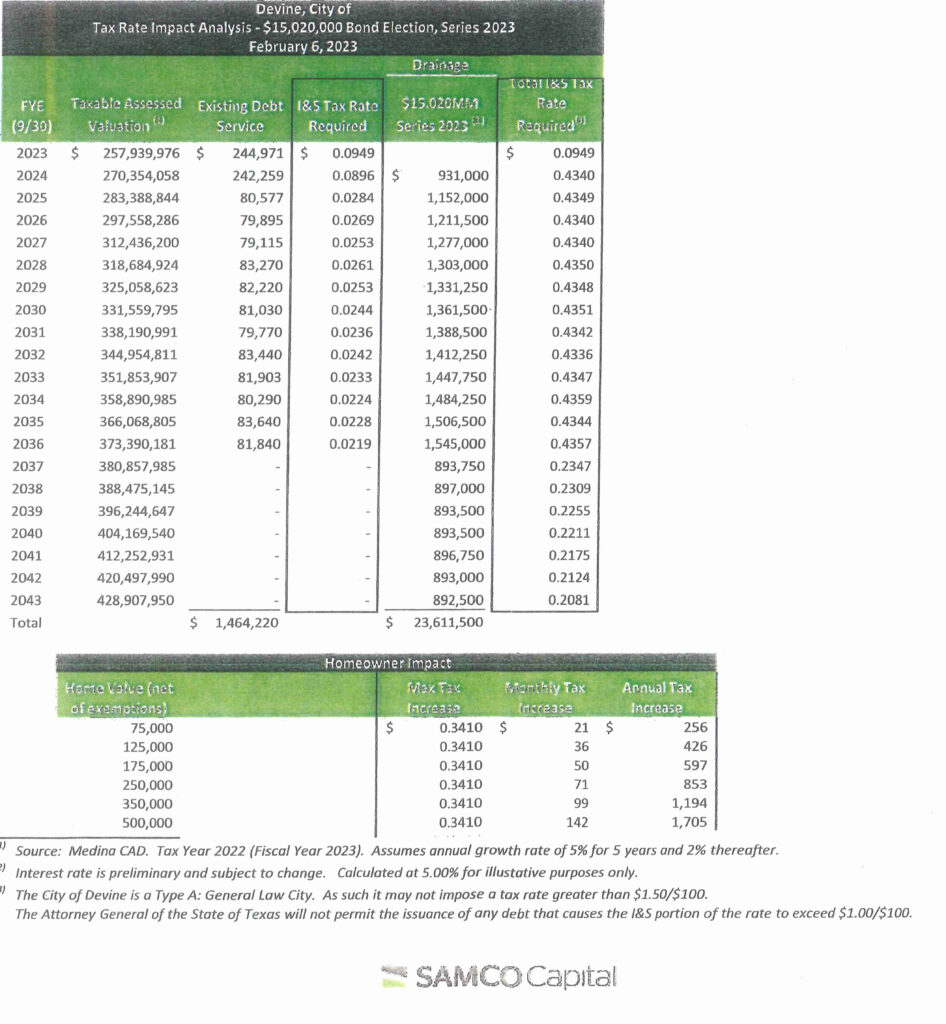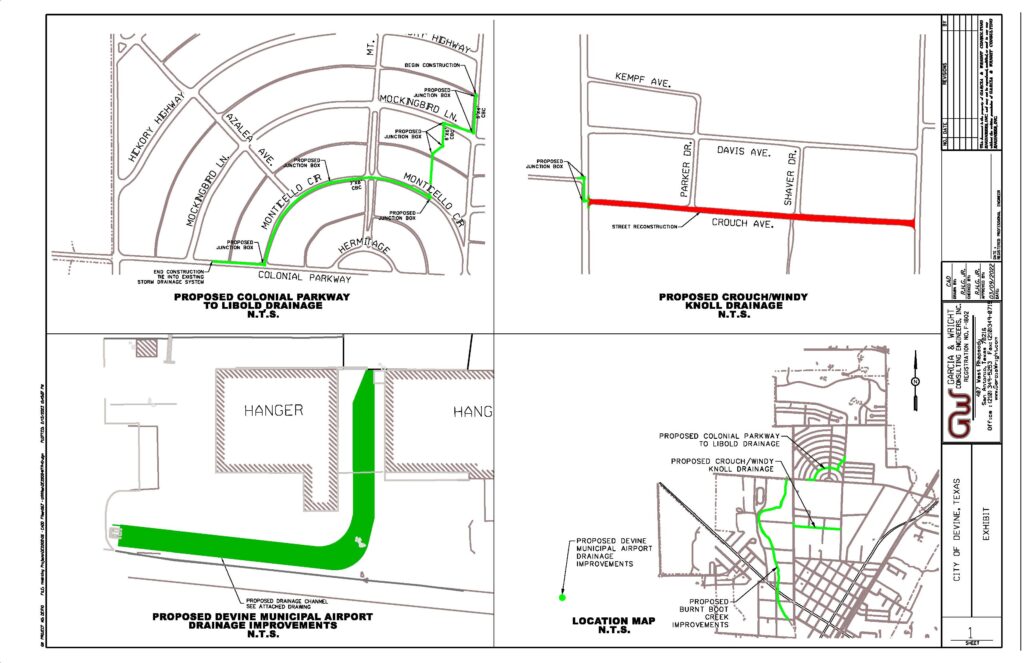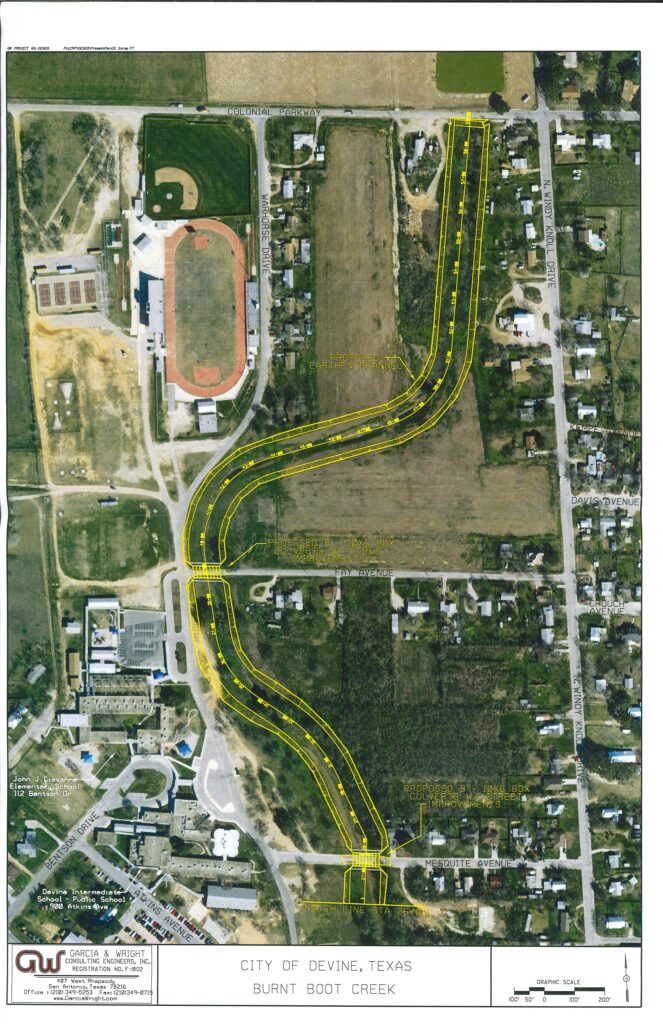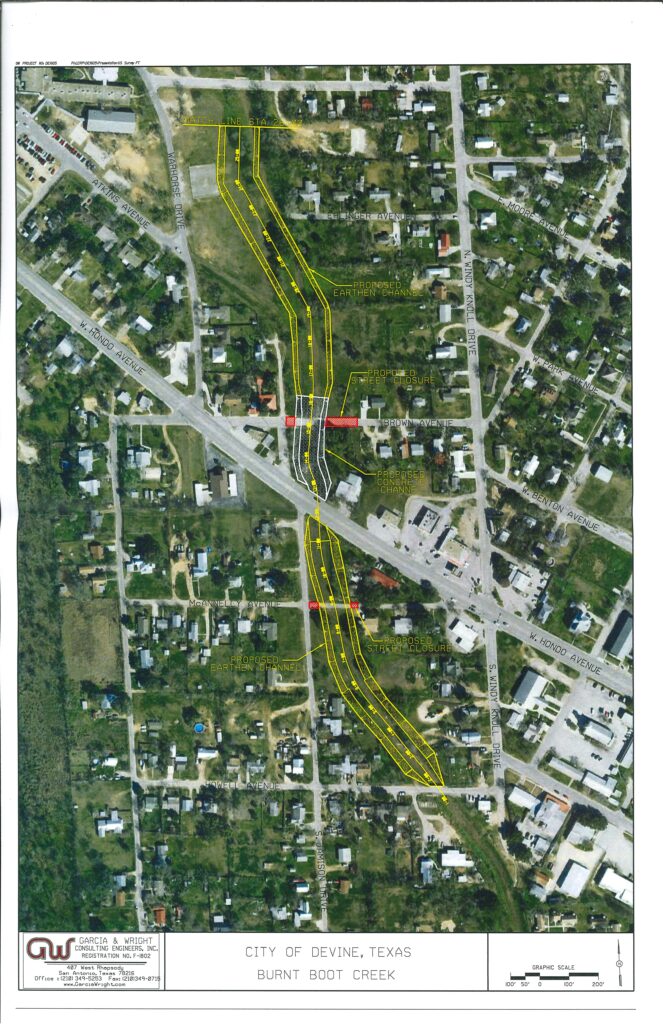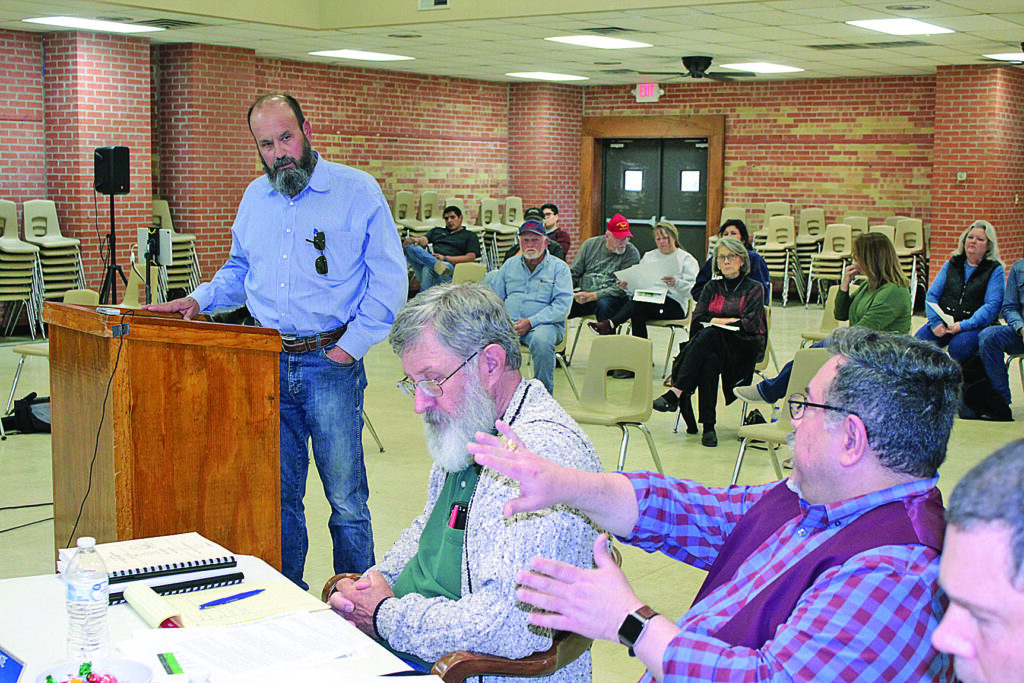
By Anton Riecher and Kathleen Calame
While incumbent Devine Mayor Cory Thompson took no position on a $15 million bond election proposed for May, he and mayoral candidate challenger Butch Cook and several others clashed over Thompson’s strict adherence to his rule of a three-minute time limit for speakers during a public hearing March 14.
“Okay, let’s open up the public hearing portion of this. I’m going to limit everybody’s time in the usual fashion for when we have doings like this to three minutes. The council is not supposed to, I’m not going to engage, that’s not the case at all, but we can’t tell you necessarily what’s our opinion. We can only deal with the facts as they are here tonight.”
Addressing the city council, Cook took issue with the strict time limit.
“We’re talking about $24 million (including interest),” he said. “Three minutes is not enough time when somebody has concerns.”
Thompson said that the three-minute limit was in keeping with how public hearings had always been run. Cook countered that he had never been limited to three minutes.
After several more voices joined the debate Thompson gaveled the discussion to a halt.
Citizens take the podium
Jessica Ornelas asked if sidewalks would be included when portions of the roadway have to be rebuilt.
City Engineer JR Garcia responded, “No”.
“I’m really confused. You say you want to improve the ability for children to walk to school but we’re not providing them a way to walk to school. You’re taking away the water but you’re not giving them an actual path,” said Ornelas.
Nancy Saathoff took the podium next and asked, “How much specifically is allocated for the airport project?” Garcia answered,”$211,000”.
Fred Morales asked, “The drainage that is going to start at the northern most portion – are those going to be square tubes in the ground or are those going to be open conveyances of water?
Garcia: “They are going to be under the ground. We will have storm drain inlets at designated locations in the design of the plans and to channelize the water essentially into Burnt Boot Creek.”
Morales: “So when you start at the north end of the project how deep below the surface are those tubes going to have to be?”
Garcia: It’s going to vary depending on what type of utilities we have in that area. We have to look at that. But typically this drainage is going to be four to six feet deep. It also depends on the slope and how … we have to look at the elevation of the existing storm drain that’s on Colonial Parkway and then work backwards to make sure we have the proper slope to get the water out.”
Morales asked, “There is no way to do it open where it’s easier to clean and maintain?”
Garcia: “No. It will have manhole openings, manhole covers on the inlets, but the actual drainage structure, no way.”
Morales: “There are not easements on right-of-ways – you just leave it open and it’s concrete and the water can move down and if something gets in it you can’t get it out or if debris gets in or anything washes in there, is there no way to move the water and keep it open?”
Garcia: “The way the water is going to be deposited into the storm drainage system is through the inlet and you’re talking about an inlet opening which is very small. When you have your big storm, it’s going to push everything out and it will end up in the creek.”
Morales: “So when the water gets to Burnt Boot and gets to the elementary school what’s going to be done south of that to make sure the water can exit town like through Zig Zag through the south end of town? If we deliver the water to the south end of town faster than it is currently being delivered, is there going to be a problem on the south end of town that we don’t have now?”
Garcia: “No, because we will be lowering the 100-year-flood plain water elevations because of the improved side flow and bottom flow and our whole point is to bring it down because there are 32 homes and buildings in that 100-year-flood plain in Devine. So the purpose of the project is to bring down that water flood elevation.”

Morales: “So there is not going to be a problem with water reaching the southern end of town faster than it is now and there isn’t anything in the project that I can see that widens or makes the waterway wider or deeper on the south side of town? We don’t want to fix the problem here and make another problem there. Want to make sure it gets the water all the way out of town.”
Garcia: “Oh yes it will. I mean of course we have the existing conditions of this area. We have San Francisco Creek – (Burnt Book Creek and San Francisco Creek) merge in the south part of town. So when you do have these 100-year flood events the back water comes back from the highway and backs up….Unless we have one of those major catastrophic events everything should be fine. For the most part most of the channel is going to be earthen, it’s going to be widened. Widening that channel the elevations are going to come down.”
Frances Navarro took the podium next.
Navarro: “What will happen if a major infrastructure failure occurs and we are unable to use another bond for our basic water needs?” (Referring to how the bond issue will cap any further general obligation bond issues for the next 20 years.)
“Why have we not used that before coming to the taxpayers? Don’t we have a grant writer on staff?”
Cunningham: “There are other means of financing. There are certificates of obligation that you could issue that you could levy a tax or utility system revenues. But for this specific project the council elected to take it to the voters to decide if you want to have these projects or not.”
Navarro: “We keep getting an increase in water … we keep getting all these issues with lines and water and broken mains all over the place. Where is all that money that we’ve already been doled out to this community by those grants by the Texas Water Board.”
Mayor Thompson responded, “That is actually, no offense, not related to … that’s a different meeting with a different discussion. I know what you’re saying but the money that’s for the water line project, that’s been five years ago …”
Navarro: “It just feels like we’re getting deeper and deeper in debt and we can’t handle basic needs around here. My water has been cut off I don’t know how many times. You call up there and you can’t get an answer.
Gary Saathoff took the podium next.
“I have a question for the engineer about the 25- and 100-year flood. This bill is going to protect 32 houses from a 100-year flood. You said that Devine has no problem with a 25-year flood for the San Francisco and the Burnt Boot Creek. So if we have a 100-year flood, it backs up into town – why don’t we take care of the whole town instead of 32 houses for a 100-year flood? … How do we decide that these flood problems are more severe than others?… Every time we get a good rain, downtown is flooded. The entire community suffers from flooding.”
Ritchey: “I appreciate the tough line of questioning. I don’t think that JR is the one that necessarily picked it out. He’s provided the engineering for the design project.”
Saathoff: “It still seems to me like you are creating better flow up top, and in a real big flood you’re going to have a bigger flood downtown because it can’t get out at the bottom.”
Thompson: “Let us quickly address the reason why the projects that were picked were picked. Based back to information that we have had going through files and folders we were able to find some of these projects with documents dating back to 1961. I think we are all aware that what happens downtown has a lot to do with the state and TxDOT helping us , with which I’m not going to say anything, but we have dozens of documents dating all the way from 1961.. They were ones that council had been concerned about in the past.”
Ralph Montgomery expressed his concerns next.
“What assurance are we going to have that this is going to be completed? Since I’ve been here I’ve already seen two or three projects into which we have put a lot of money that have not been completed,” stated Montgomery. What happened to all that money for these other projects that were never completed? What happened to that money?”
Ritchey said: “I think it was said in a previous meeting that if we don’t compete it in five years we have to pay it back.”
Montgomery named several projects that have not been completed. “One is the water line project going down Libold. Never completed.”
Thompson: “Are you referencing the water line project we are currently working on? Guys are out working on it right now. That’s why people keep losing water up in District 1.”
Butch Cook took the podium next. “I have to be super quick apparently.”
Cook questioned Garcia about the difference between a 25- and a 100- Year Flood.
Garcia said the project is designed based on taking care of a 25 year flood plain.“We could not design for a 100-year flood,” Garcia replied.
Cook: We’re going to spend $24 million. Because it’s $15 million plus, on your chart, $9 million in interest for 20 years … It would seem to me that it must be quite comprehensive and also include life threatening situations and things that could have happened. I have heard of none. Even back in 2011 when we had eight-inches in two hours. My shop got flooded, yes it did, but what the hey, eight inches in two hours is going to do that. The whole town was flooded down here. I don’t mean to dismiss the threat of bodily injury to anyone, but we haven’t had any (inside city limits).”
Cook said he had checked old council minutes going back four years. “Only three meeting in four years had anything posted regarding drainage. Those three involved complaints from Montgomery. Of those three agendas, there were six total items. At least three of these aren’t even on these plans.”
“Why the rush? This thing was rushed in incredibly quickly. Two short notice special meetings just so it could be on the May ballot. What was the reason? Anyone?,” asked Cook.
Thompson: We were aware we were going out for this. We had this discussion back in October or November? We were compiling these items.”
Cook: “In October you addressed the council during a special meeting asking for the council to consider a bond proposal for street paving, a sports complex, and drainage. You personally approached the council wanting the bond proposal … Now, here we are with no regular meeting with regard to this issue, two special meetings that hardly anyone attended with 72-hour notice and they start at 6 p.m. … You posted that this project will max out our tax rate for 20 years and would not allow us to do anything substantial in the way of community improvement for the next 20 years. Why would we want to do that?”
Thompson: “That is up to the voters to decide.”
Cook: “No, no, you guys presented this for the voters. There is an inherent trust that it has been researched, and that YOU approve of it is why it goes out for a vote. So why would we want to max out our tax rate and our ability to improve other things for 20 years.”
Randall: “All of these projects I know we have discussed maybe it’s informational, maybe it’s not on the agenda, but we’ve talked about them many times. However, we as a city don’t have $15 million to do this project. And we get asked about these projects a lot. It’s not just fly-by that we came up with them. We’re giving it to the residents to decide – ‘do you want this done and this is the cost?’”
Cook: “We need to promote projects that can bring in new business and help with sales tax revenue.”
Next, Kathleen Calame took the podium.
“Why does the project stop at Howell Street (near the funeral home)? Why does it not go all the way down to Hwy 132 where Burnt Boot Creek actually exits town? That area after Howell Street is overgrown with trees and brush and has been neglected for many, many years, yet it’s not being taken into account or corrected and will cause huge problems for the flow of the water.”
Garcia; “Well, that comes under understanding the engineering portion and how it’s designed. I would have to come and meet with everybody and have a three-hour class and how I designed this thing. I can’t really explain how it’s designed here because it would take too long. But it is designed to where the water elevation drops so whatever the water surface elevation is right now it is going to be dropped by one-third entering Burnt Boot Creek.”
Garcia said the project is based by calculations done by his father 10 + years ago.
Calame: “Who chose these projects?”
Thompson: “They were on a list of projects that have been around many, many years. I can’t necessarily choose projects one way or another. I asked the council for a vote. What you see here tonight was voted on by the council.” (Council vote was split 3 for (Randall, Espinosa and Vega) and 2 against (Pichardo and Ritchey).
Next, Pichardo expressed some concerns : “I do have a statement. JR I know that the flooding is going to end over in district 2 and I want to reassure our residents. So we would like to meet for those three hours to have that explanation, so that way we understand, and I can explain to my residents that they’re not going to be flooded out. And I do understand we have 32 homes and we need to save those homes but, in addition, are we going to destroy another part of town possibly … I know that you used the stock list from the Army Corp of Engineers but have they come to actually visually see? Has the Army Corp of Engineers come to give us some advice …? (Thompson tries to interupt) … to see that the flood does not happen in district 2? I’m just worried about this.”
Gary Saathoff asked next: “Quick question. In the dream sheet that you showed, it all adds up to $90 million. Have all of those projects, has there been any determination besides the cost on how many people it will benefit? Each one of those items, like a sports complex, is going to cost this much, is going to benefit this many people. This flood project is going to cost $15 million and it’s going to benefit this many people. Any of the others on there, the airport, who is it going to benefit …?… to give you a ranking of what would be most beneficial to the city.”
Thompson: “To answer that question we actually do have that on the airport because the airport was part of what we’re discussing now. Once council made a decision what we were working with, we went out and got the analysis for how many people would be affected. All I can say about the sports complex because you brought up the sports complex, and it has been brought up a couple of times tonight, is the sports complex we actually looked at does not match the, uh, what is the sheet the Parks and Recreation board came up with … the master plan. The sports complex did not actually match the master plan as created by the Parks and Recreation Department so if we had gone with the sports complex project we would actually would have to have had a different discussion because what we had on our master plan and what the sports complex was were two different things. So …”
Cook: “Just a comment.”
Thompson: “You’ve already had your time. You know that’s right. (Laughing) You want me to gavel you again? (Thompson uses gavel.)”
Ernesto Auguilar spoke next.
Aguilar: “I see that Burnt Boot Creek is going to benefit 32 homes, Crouch is going to benefit 45 homes. I don’t see a number on Colonial? How many homes are we estimating in that and then what is the average value of a house here in Devine?”
Garcia: “I don’t have that number, for how many homes.”
Aguilar: “And what is the average value on a home in Devine?”
Thompson: “Dora, do we have the update on the average cost of a house in Devine? It would need to be specific to this neighborhood.”
Interim Admin. Dora Rodriguez: “The report that we get doesn’t show an average.”
Aguilar: “How much is the allocation to the airport again? How much income is generated by the airport?”
Garcia: “$211,000.”
Thompson “We don’t have that figure right now. Like I said we have talked about the airport in the past. It would be an entirely different discussion.”
Aguilar: “And then you had talked about the project tapping from the Monticello area, you’re going to tap into existing drainage?”
Garcia: “Yes, there is an existing drainage there from Colonial Parkway that ties into Burnt Boot Creek. We’re going to tie into that existing system.
Aguilar: “Can it handle it?”
Garcia: “Yes, it can. It was designed based on peak periods.”
HOW IS SPEAKING TIME TABULATED?
Mrs. Saathoff asks Thompson how total time to speak is tabulated. Thompson explains that he is only clocking time spent talking, not waiting for an answer or the answer itself.
Thompson: “Technically, you have about eight seconds left on your time [to Mrs. Saathoff].”
Calame: “Is the three-minute limit a state law or is this a local thing you came with? Some meetings you go to, you can talk as long as you want. Who came up with that rule? “
Thompson: “It is actually within my power as mayor, because everyone came here to talk on the same topic… I can force you to vote on one representative to speak for all of you.”
Navarro: “Forcing us to that particular amount of time when you call a hearing for the public to express their concerns and then as mayor say ‘You only have this much time’ you’re limiting the discussion so it doesn’t give the community confidence that you’re willing to hear us out.”
